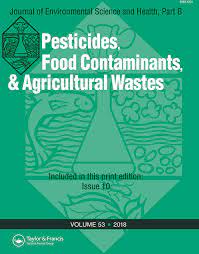Ver ítem
- xmlui.general.dspace_homeCentros Regionales y EEAsCentro Regional Chaco - FormosaEEA Las BreñasArtículos científicosxmlui.ArtifactBrowser.ItemViewer.trail
- Inicio
- Centros Regionales y EEAs
- Centro Regional Chaco - Formosa
- EEA Las Breñas
- Artículos científicos
- Ver ítem
Degradation of atrazine, glyphosate, and 2,4-D in soils collected from two contrasting crop rotations in Southwest Chaco, Argentina
Resumen
Argentina stands as one of the leading consumers of herbicides. In a laboratory incubation experiment, the persistence and production of degradation metabolites of Atrazine, 2,4-D, and Glyphosate were investigated in a loamy clay soil under two contrasting agricultural practices: continuous soybean cultivation (T1) and intensified rotations with grasses and legumes (T2). The soils were collected from a long-term no-till trial replicating the influence of
[ver mas...]
Argentina stands as one of the leading consumers of herbicides. In a laboratory incubation experiment, the persistence and production of degradation metabolites of Atrazine, 2,4-D, and Glyphosate were investigated in a loamy clay soil under two contrasting agricultural practices: continuous soybean cultivation (T1) and intensified rotations with grasses and legumes (T2). The soils were collected from a long-term no-till trial replicating the influence of the meteorological conditions in the productive region. The soil was enriched with diluted concentrations of 6.71, 9.95, and 24 mg a.i./kg-1 of soil for the respective herbicides, equivalent to annual doses commonly used in the productive region. Samples were taken at intervals of 0, 0.5, 1, 2, 4, 6, 8, 16, 32, and 64 days, and analysis was conducted using high-resolution liquid chromatography UPLC MS/MS. An optimal fit to the first-order kinetic model was observed for each herbicide in both rotations, resulting in relatively short half-lives. Intensified crop sequences favored the production of biotic degradation metabolites. The impact of the high frequency of soybean cultivation revealed a trend of soil acidification and a reduced biological contribution to attenuation processes in soil contamination.
[Cerrar]

Fuente
Journal of Environmental Science and Health, Part B Pesticides, Food Contaminants, and Agricultural Wastes 59: 1 (2024)
Fecha
2024-01-31
Editorial
Taylor & Francis
ISSN
0360-1234 (print)
1532-4109 (online)
1532-4109 (online)
Formato
pdf
Tipo de documento
artículo
Palabras Claves
Derechos de acceso
Restringido
 Excepto donde se diga explicitamente, este item se publica bajo la siguiente descripción: Creative Commons Attribution-NonCommercial-ShareAlike 2.5 Unported (CC BY-NC-SA 2.5)
Excepto donde se diga explicitamente, este item se publica bajo la siguiente descripción: Creative Commons Attribution-NonCommercial-ShareAlike 2.5 Unported (CC BY-NC-SA 2.5)


